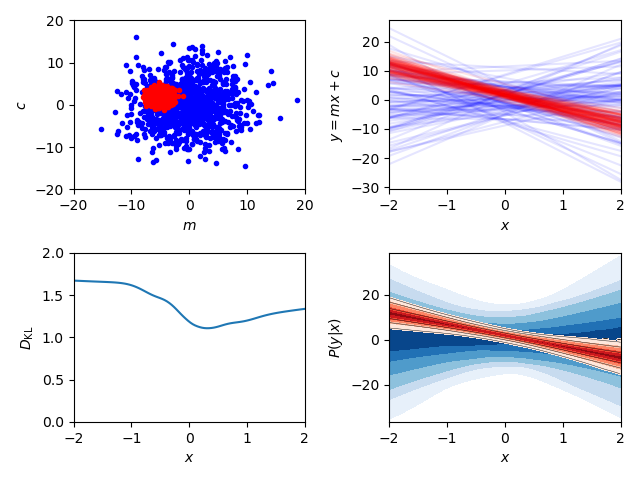fgivenx: Functional Posterior Plotter
Project description
- fgivenx:
Functional Posterior Plotter
- Version:
- 2.1.6
- Homepage:
- Documentation:






Description
fgivenx is a python package for plotting posteriors of functions. It is currently used in astronomy, but will be of use to any scientists performing Bayesian analyses which have predictive posteriors that are functions.
These packages allow one to plot a predictive posterior of a function, dependent on sampled parameters. We assume one has a Bayesian posterior Post(theta|D,M) described by a set of posterior samples {theta_i}~Post. If there is a function parameterised by theta f(x;theta), then this script will produce a contour plot of the conditional posterior P(f|x,D,M) in the (x,f) plane.
The driving routine is fgivenx.compute_contours, and Example Usage can be found by running help(fgivenx). It is compatible with getdist, and has a loading function provided by fgivenx.samples.samples_from_getdist_chains.
Getting Started
Users can install using pip:
pip install fgivenxfrom source:
git clone https://github.com/williamjameshandley/fgivenx
cd fgivenx
python setup.py install --useror for those on Arch linux it is available on the AUR
You can check that things are working by running the test suite:
pytest
# or, equivalently
python setup.py testCheck the dependencies listed in the next section are installed. You can then use the fgivenx module from your scripts.
Dependencies
Basic requirements:
Python 2.7+ or 3.4+
matplotlib
numpy
scipy
Documentation:
sphinx
numpydoc
Tests:
pytest
pytest-cov
Optional:
joblib (parallelisation)
getdist (compatibility with getdist chains)
tqdm (progress bars)
Documentation
Full Documentation is hosted at ReadTheDocs. To build your own local copy of the documentation you’ll need to install sphinx. You can then run:
cd docs
make htmlCitation
If you use fgivenx to generate plots for a publication, please cite as:
@article{fgivenx,
doi = {10.21105/joss.00849},
url = {http://dx.doi.org/10.21105/joss.00849},
year = {xxxx},
month = {xxx},
publisher = {The Open Journal},
volume = {X},
number = {X},
author = {Will Handley},
title = {fgivenx: Functional Posterior Plotter},
journal = {The Journal of Open Source Software}
}Example Usage
import numpy
import matplotlib.pyplot as plt
from fgivenx import compute_samples, compute_pmf, compute_dkl
from fgivenx.plot import plot, plot_lines
# Model definitions
# =================
# Define a simple straight line function, parameters theta=(m,c)
def f(x, theta):
m, c = theta
return m * x + c
numpy.random.seed(1)
# Posterior samples
nsamples = 1000
ms = numpy.random.normal(loc=-5, scale=1, size=nsamples)
cs = numpy.random.normal(loc=2, scale=1, size=nsamples)
samples = numpy.array([(m, c) for m, c in zip(ms, cs)]).copy()
# Prior samples
ms = numpy.random.normal(loc=0, scale=5, size=nsamples)
cs = numpy.random.normal(loc=0, scale=5, size=nsamples)
prior_samples = numpy.array([(m, c) for m, c in zip(ms, cs)]).copy()
# Computation
# ===========
# Examine the function over a range of x's
xmin, xmax = -2, 2
nx = 100
x = numpy.linspace(xmin, xmax, nx)
# Set the cache
cache = 'cache/test'
prior_cache = cache + '_prior'
# Compute function samples
fsamps = compute_samples(f, x, samples, cache=cache)
prior_fsamps = compute_samples(f, x, prior_samples, cache=prior_cache)
# Compute dkls
dkls = compute_dkl(f, x, samples, prior_samples, cache=cache, parallel=True)
# Compute probability mass function.
y, pmf = compute_pmf(f, x, samples, cache=cache, parallel=True)
y_prior, pmf_prior = compute_pmf(f, x, prior_samples, cache=prior_cache, parallel=True)
# Plotting
# ========
fig, axes = plt.subplots(2, 2)
prior_color = 'b'
posterior_color = 'r'
# Sample plot
# -----------
ax_samples = axes[0, 0]
ax_samples.set_ylabel(r'$c$')
ax_samples.set_xlabel(r'$m$')
ax_samples.plot(prior_samples.T[0], prior_samples.T[1], color=prior_color, marker='.', linestyle='')
ax_samples.plot(samples.T[0], samples.T[1], color=posterior_color, marker='.', linestyle='')
# Line plot
# ---------
ax_lines = axes[0, 1]
ax_lines.set_ylabel(r'$y = m x + c$')
ax_lines.set_xlabel(r'$x$')
plot_lines(x, prior_fsamps, ax_lines, color=prior_color)
plot_lines(x, fsamps, ax_lines, color=posterior_color)
# Predictive posterior plot
# -------------------------
ax_fgivenx = axes[1, 1]
ax_fgivenx.set_ylabel(r'$P(y|x)$')
ax_fgivenx.set_xlabel(r'$x$')
cbar = plot(x, y_prior, pmf_prior, ax_fgivenx, colors=plt.cm.Blues_r, lines=False)
cbar = plot(x, y, pmf, ax_fgivenx, colors=plt.cm.Reds_r)
# DKL plot
# --------
ax_dkl = axes[1, 0]
ax_dkl.set_ylabel(r'$D_\mathrm{KL}$')
ax_dkl.set_xlabel(r'$x$')
ax_dkl.plot(x, dkls)
ax_dkl.set_ylim(bottom=0)
ax_lines.get_shared_x_axes().join(ax_lines, ax_fgivenx, ax_samples)
fig.tight_layout()
fig.savefig('plot.pdf')Project details
Release history Release notifications | RSS feed
Download files
Download the file for your platform. If you're not sure which to choose, learn more about installing packages.












